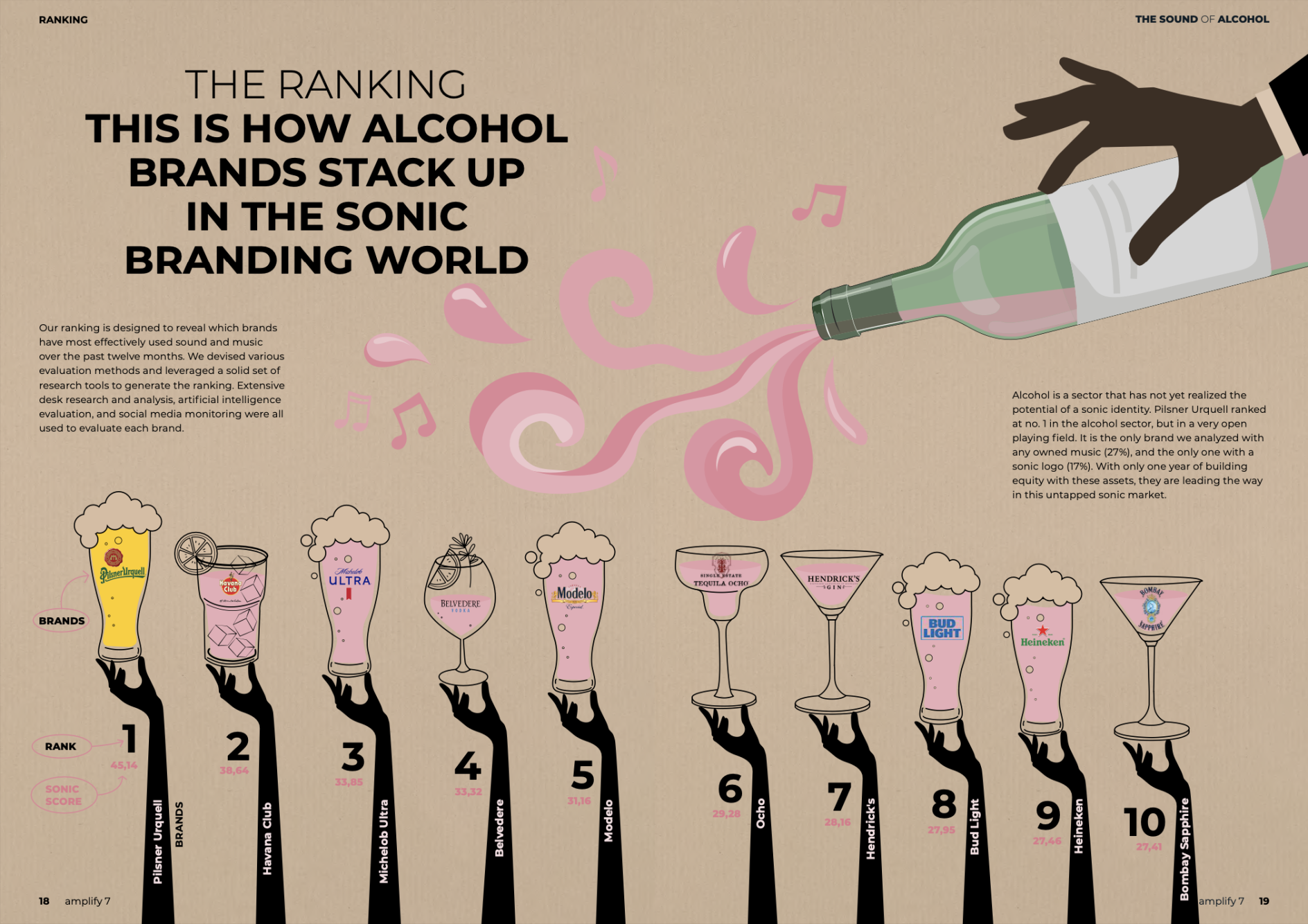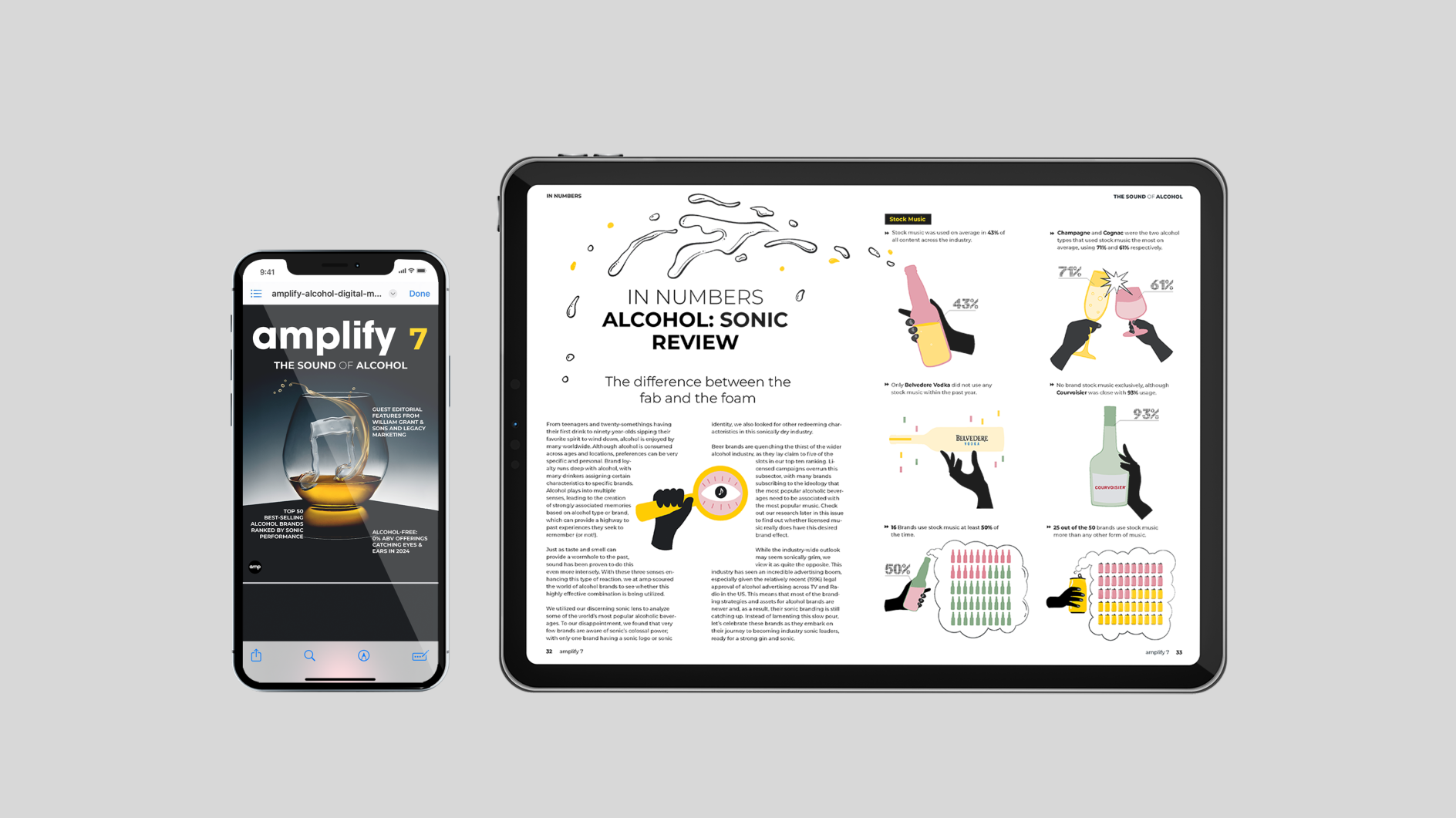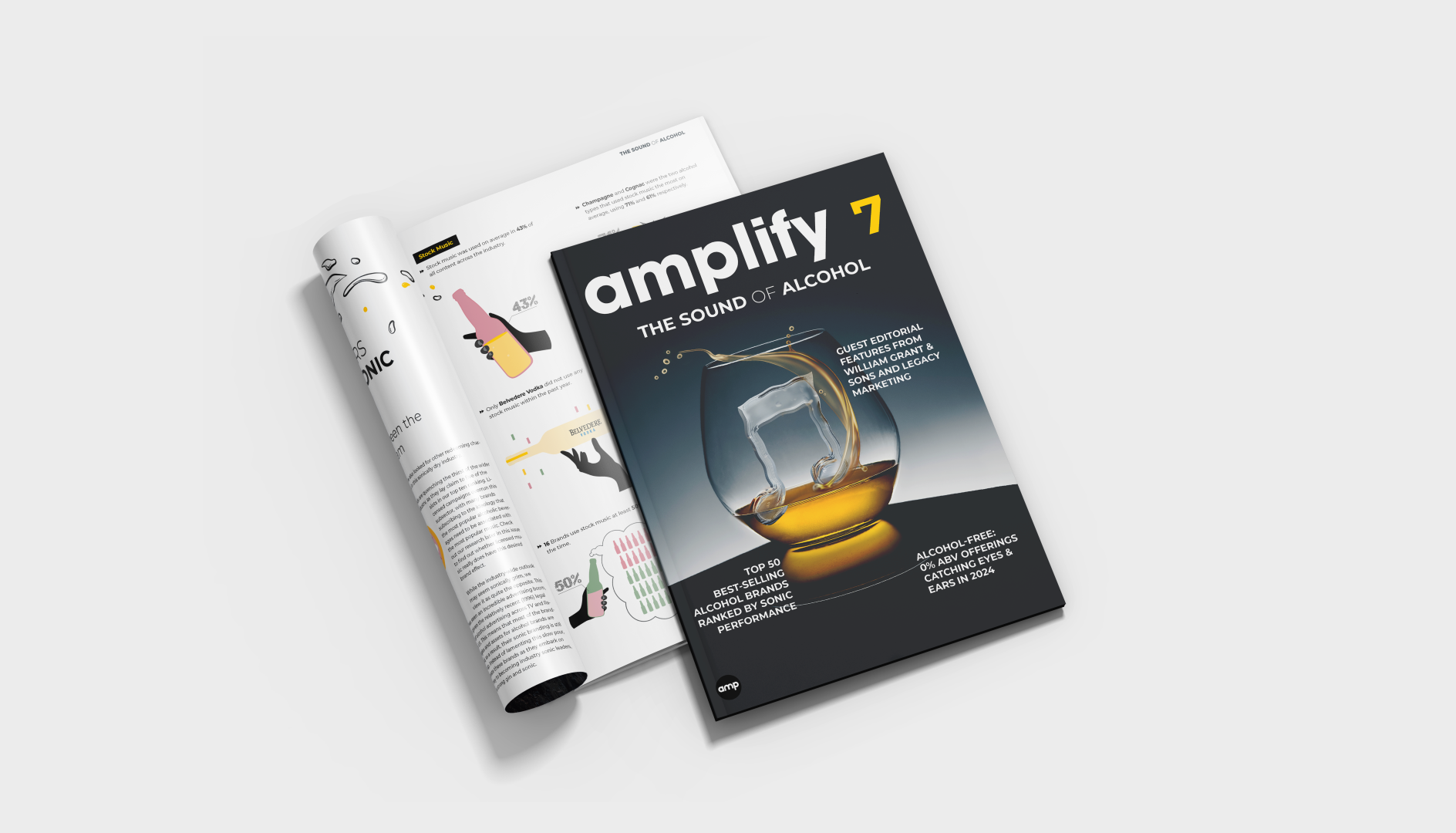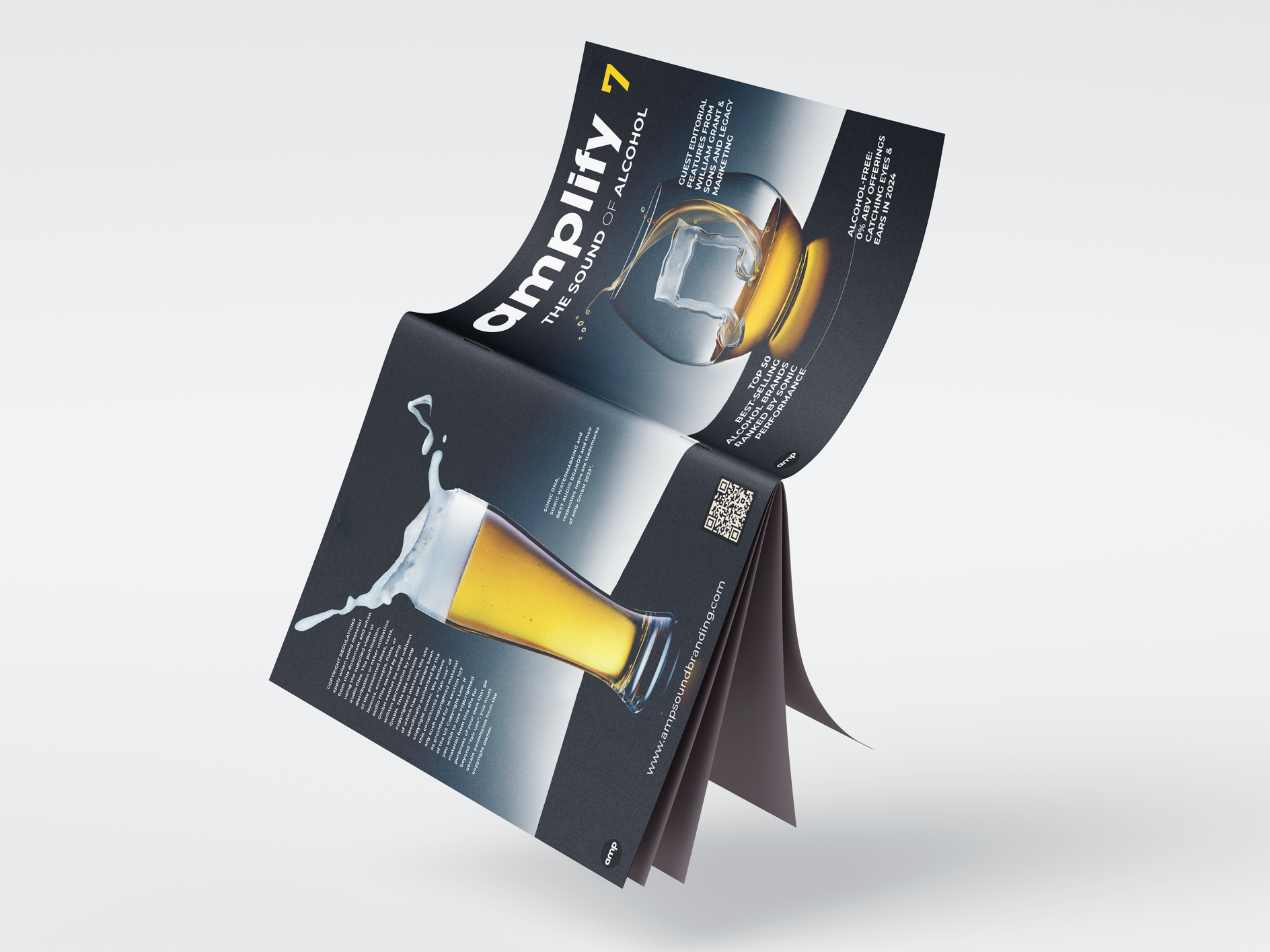Why Is Sonic Branding Being Overlooked in the Alcohol Sector?
When you think about brand design, visual and verbal elements often come to mind, but having a successful brand is about more than just how it looks and reads on paper. According to sonic branding agency Amp, having a sound identity or a sonic logo is just as important in fostering brand recognition and communicating value to consumers.
The latest set of research from Amp's Research & Insights team delves into the sonic identities – or lack thereof – in the alcohol sector. Through extensive desk research, social media monitoring, and AI evaluation provided by Amp's Sonic Hub tech platform, the studio has analysed and ranked the top 50 alcohol brands by their use of music and sound (over the last 12 months) based on the top five brands from each sector by market share.
Looking into the alcohol sector was a decision spurred by both professional curiosity and personal experience for Amp's head of research & insights Bjorn Thorleifsson, who worked as a bartender during his university years. It was during this time that he noticed how the sonic ambience played a crucial role in the success of bars.

"Music is ubiquitous in alcohol-related settings, from bars and clubs to sporting events", says Thorleifsson. "While some brands have previously experimented with sonic branding, it seemed surprising that larger market shareholders hadn't fully embraced this concept, which led us to explore the potential benefits and pitfalls of sonic branding in the alcohol industry."
Surprisingly, the alcohol sector has very little owned music, according to the research, with Pilsner Urquell leading owned music usage in the market with 27%. Havana Club, Michelob Ultra, Belvedere, and Modelo round out the top five ranking with descending sonic scores. Amp also found that beer brands claimed 50% of the top ten slots in the ranking.
Overall, though, the alcohol sector is suffering from a wildly expensive licensing habit and an overreliance on lacklustre stock music, which makes up 43% of all content in the sector.

H2 Over-reliance on stock music
Thorleifsson puts the prevalence of stock music in the alcohol sector down to a combination of factors primarily driven by cost considerations. He says: "Brands often find themselves turning to stock music as a cost-effective solution to meet their sonic branding needs".
"This reliance on stock music stems from either a lack of strategic approach to sonic branding or starting from an ill-informed standpoint." In the absence of a cohesive sonic identity, brands are forced towards licensed music, custom music, or stock music.
While licensed music is familiar, it is usually the most expensive option and often doesn't align with the brand's identity. Custom music can be cheaper, but still requires significant investment when developing a long-term sonic strategy and using stock music – the most affordable option – runs the risk of entering a sea of sameness.
While it's easy to assume that stock music is a pragmatic choice for alcohol brands lacking a defined sonic identity, Thorleifsson thinks that this approach "overlooks the potential for differentiation and brand enhancement through strategic sonic branding".
He also suggests that using stock music isn't always a cost-related choice but can sometimes be driven by the fact that brands believe they have "reached the pinnacle of brand recognition", and so they overlook opportunities to enhance it further. Amp's research found this to be particularly true with champagne brands, which use a combined 90% "stock music" and "no music" in external marketing communications.

H2 A chance to boost consumer connections
What alcohol brands are missing is the opportunity to "foster a deeper connection" and "strengthen brand recall" among consumers, which, in turn, leads to "a sense of belonging among customers" when they can instantly recognise a brand's sound, Thorleifsson explains.
Amp also infers that ownable sounds bring added exclusivity and quality to a brand, enhancing its overall image in the eyes of consumers.
Some secondary benefits of having a sonic logo include the ability to leverage these sounds to create immersive brand experiences. Thorleifsson notes how Corona has "embraced the concept of hosting venues" and can curate" a cohesive brand experience for customers, reinforcing their brand values while serving their products" using their sonic identity.
He adds that having an ownable sound identity "opens up opportunities for creative collaborations and marketing initiatives, as brands can enlist guest artists to interpret their sonic identity or even create new compositions inspired by it". Not only does this diversify brand engagement, but it also generates excitement and fosters memorability, as proven by campaigns like Just Eat's, which has featured artists like Snoop Dogg and Katy Perry.
So, while recognition is a core benefit of sonic identity, it can also allow brands to forge deeper connections with consumers, elevate their brand image, and present opportunities for immersive brand experiences.

H2 Prioritising implementation
How do you translate a brand's values into musical representation?
This is one of the main challenges when creating a sonic logo, according to Thorleifsson. The solution involves "leveraging insights from successful past campaigns or drawing inspiration from visual elements of the brand"; however, he reveals how the most effective approach typically involves "collaboration with experts well-versed in the psychology of music". These experts are the ones who can "interpret the brand's essence and ensure alignment with its multifaceted identity".
After creation comes implementation, which hinges on securing a consistent buy-in from stakeholders across all markets, as Thorleifsson says "disparities in adoption can undermine the efficacy of the sonic identity and impede efforts to cultivate brand equity". A disproportionate rollout of a sonic identity could not only dilute its impact but also inhibit the consumer's ability to associate specific sounds with the brand, meaning the whole process of finding and creating a sound would amount to very little in terms of results.
Ensuring the "long-term viability and distinctiveness" of a brand's sonic identity should always be the focus, says Thorleifsson, as the creation of a flexible and holistic sonic identity demands "meticulous planning and well-thought-out execution".
Two experts in the space – William Grant & Sons global creative content manager Fabiano Latham and Legacy Marketing head of creative April Quealy – also shed light on the state of sonic branding in the alcohol industry in Amp's latest Amplify issue: "The Sound of Alcohol".
In the issue, Latham explains how sound is a crucial asset in the content creation realm for alcohol brands, while Quealy makes the point that brands investing in sound will not only stand out but appear more authentic to consumers, delving into how sound is key in rounding out the sensorial experience of drinking and highlighting how activating the senses can secure consumer connection.
Source: creativeboom.com
